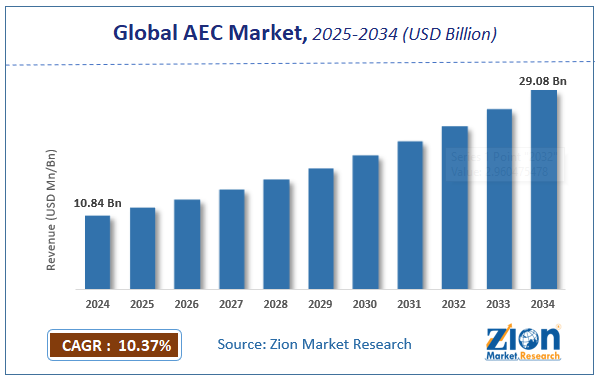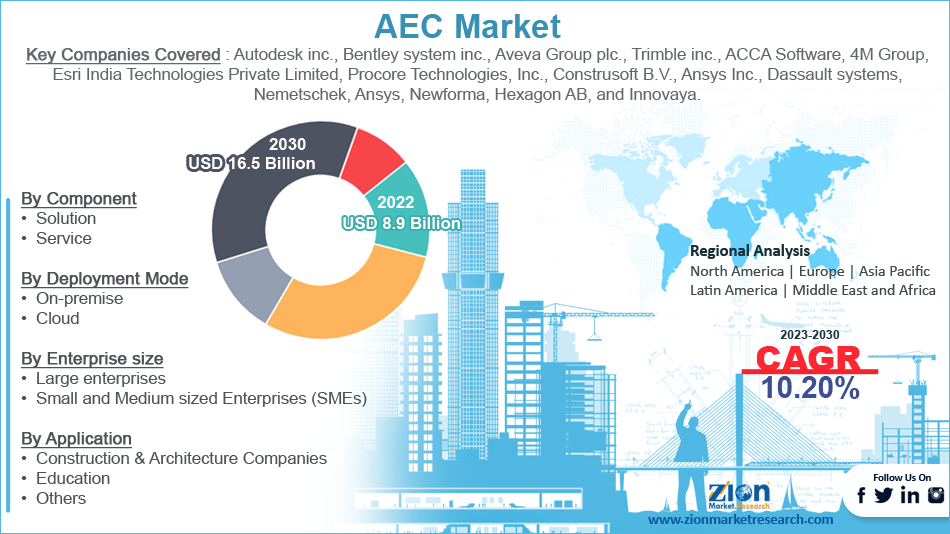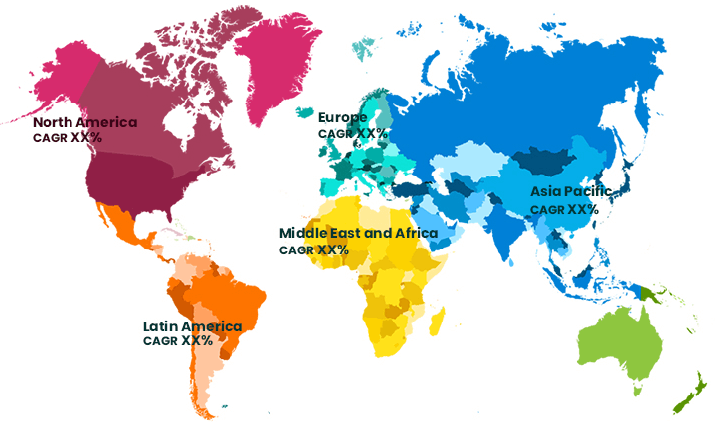AEC Market Size, Share & Trends Analysis 2034

AEC Market By Component (Software and Services), By Deployment Mode (On-Premise and Cloud), By Enterprise Size (Large Enterprises and Small & Medium Enterprises), By Application (Construction & Architecture Companies, Education, and Others), By Project Life Cycle (Preconstruction, Construction, and Operations), and By Region: Global and Regional Industry Overview, Market Intelligence, Comprehensive Analysis, Historical Data, and Forecasts 2025 - 2034
| Market Size in 2024 | Market Forecast in 2034 | CAGR (in %) | Base Year |
|---|---|---|---|
| USD 10.84 Billion | USD 29.08 Billion | 10.37% | 2024 |
AEC Market: Industry Perspective
The global AEC market size was worth around USD 10.84 billion in 2024 and is predicted to grow to around USD 29.08 billion by 2034 with a compound annual growth rate (CAGR) of roughly 10.37% between 2025 and 2034. The report analyzes the global AEC market's drivers, restraints/challenges, and the effect they have on the demand during the projection period. In addition, the report explores emerging opportunities in the AEC industry.
AEC Market: Overview
For successful project life cycle management, real estate businesses, construction firms, surveyors, interior designers, and mechanical & electrical piping engineers employ architecture, engineering, and construction (AEC) software. The primary goal of AEC software is to improve project performance and results. Construction managers benefit from AEC's assistance in gathering data and information from many disciplines and communicating more efficiently. Increased construction efficiency is combined with improved data transmission and coordination among numerous stakeholders, architects, and construction supervisors to provide AEC users with a competitive advantage.
Key Insights
- As per the analysis shared by our research analyst, the global AEC market is estimated to grow annually at a CAGR of around 10.37% over the forecast period (2025-2034).
- Regarding revenue, the global AEC market size was valued at around USD 10.84 billion in 2024 and is projected to reach USD 29.08 billion by 2034.
- The AEC market is projected to grow at a significant rate due to Digital transformation, BIM adoption, and increased infrastructure investments drive growth. Demand for efficient project management and collaboration tools supports the market.
- Based on Component, the Software segment is expected to lead the global market.
- On the basis of Deployment Mode, the On-premises segment is growing at a high rate and will continue to dominate the global market.
- Based on the Enterprise Size, the Large Enterprises segment is projected to swipe the largest market share.
- By Application, the Construction & Architecture Companies segment is expected to dominate the global market.
- In terms of the Project Life Cycle, the Preconstruction segment is anticipated to command the largest market share.
- Based on region, North America is predicted to dominate the global market during the forecast period.
AEC Market: Growth Drivers
Surge in infrastructure projects is likely to offer better growth opportunities.
As the world's population grows, so does the need for new buildings, malls, and workplaces, thanks to the advent of initiatives like smart cities and high-speed roadways. As a result, important stakeholders are using AEC software to run these projects smoothly and effectively. In the Middle East and most growing Asia Pacific nations, such as India and China, the building sector has grown rapidly.
For example, in 2017, Saudi Arabia launched a slew of major projects, including the King Abdullah Economic City in Rabigh, which is expected to cost roughly USD 27 million. In contrast, the Abu Dhabi Development Authority declared a budget of USD 6.8 million for Airport Expansion and a USD 500 million project for the Presidential Palace in Al-Ras Al—Akhdar in the United Arab Emirates. These forthcoming projects are predicted to increase end-user usage of engineering software such as CAM, CAD, BIM, and AEC, boosting the AEC market growth.
AEC Market: Restraints
High initial costs are likely to hamper the growth of the global market
Despite the numerous advantages and cost reductions connected with architecture, engineering, and construction (AEC) software, the initial cost is substantial. For example, Autodesk's Revit software costs between USD 3,000 and USD 5,000. Aside from the cost of the program, the cost of training and services is also rather significant. As a result, the high initial cost of AEC may stifle market expansion.
AEC Market: Opportunities
Increasing trend of IoT in the construction industry is likely to project great opportunities for market expansion.
Modeling and ordering procedures can become simpler with the use of IoT in construction, and the appropriate material can be supplied straight to the building site, eliminating the time needed for ordering. Also, prefabrication can benefit from IoT technologies. Using prefabricated building components instead of traditional building methods can result in better and more cost-effective solutions, as well as reduced construction waste. On the other hand, employing prefab for major commercial construction projects might be difficult to coordinate with the entire construction lifecycle. As a result, the Internet of Things (IoT) can assist in resolving this issue.
AEC Market: Challenges
Lack of trained professionals poses a great challenge to the market growth
The construction industry still lacks trained technical professionals in many parts of the world. Companies are facing difficulties in getting trained when they are dealing with two of the most challenging, fast-paced sectors imaginable. Also, it is much more difficult when staff are compelled to use obsolete technology that reduces productivity. Plus, it's not only architects and engineers that are in short supply in the AEC business; the gap between available employment and available talent is much larger.
AEC Market: Segmentation Analysis
The global AEC market is segmented based on Component, Deployment Mode, Enterprise Size, Application, Project Life Cycle, and region.
Based on Component, the global AEC market is divided into Software and Services.
On the basis of Deployment Mode, the global AEC market is bifurcated into On-premise and Cloud. The on-premise segment held the largest market share in 2024 and is further predicted to occupy a dominant market share during the forecast period. The major reason for the growth of this segment is the growing concerns related to the security of data on various projects. Thus, the maintenance of data security in construction projects is paramount as they are very valuable for companies. Various prominent companies in the AEC sector offer functional on-premise software for their wide range of customers in the infrastructure, industrial, and residential sectors. These factors drive the growth of the on-premise segment during the forecast period.
By Enterprise Size, the global AEC market is split into Large Enterprises and Small & Medium Enterprises. The large enterprise segment held the largest market share in 2024 and is further predicted to grow exponentially at a rapid CAGR during the forecast period. The main reason behind the growth of this segment is that large enterprises tend to spend and invest more in innovative and breakthrough technologies to significantly improve overall productivity and complete projects in a much shorter duration. Thus, an increase in the integration of virtual reality, augmented reality, and the Internet of Things (IoT) with AEC among large enterprises drives the growth of the segment during the forecast period.
In terms of Application, the global AEC market is categorized into Construction & Architecture Companies, Education, and Others.
By Project Life Cycle, the global AEC market is divided into Preconstruction, Construction, and Operations.
AEC Market: Report Scope
| Report Attributes | Report Details |
|---|---|
| Report Name | AEC Market |
| Market Size in 2024 | USD 10.84 Billion |
| Market Forecast in 2034 | USD 29.08 Billion |
| Growth Rate | CAGR of 10.37% |
| Number of Pages | PagesNO |
| Key Companies Covered | Autodesk Inc., Bentley Systems Inc., Aveva Group plc., Trimble Inc., ACCA Software, 4M Group, Esri India Technologies Private Limited, Procore Technologies, Inc., Construsoft B.V., Ansys Inc., Dassault Systèmes, Nemetschek, Ansys, Newforma, Hexagon AB, and Innovaya, and others. |
| Segments Covered | By Component, By Deployment Mode, By Enterprise Size, By Application, By Project Life Cycle, and By Region |
| Regions Covered | North America, Europe, Asia Pacific (APAC), Latin America, The Middle East and Africa (MEA) |
| Base Year | 2024 |
| Historical Year | 2020 to 2024 |
| Forecast Year | 2025 to 2034 |
| Customization Scope | Avail customized purchase options to meet your exact research needs. Request For Customization |
AEC Market: Regional Analysis
North America to maintain its dominance over the global market during the forecast period
North America held the major share of the global AEC market in 2024. This is owing to a significant expansion in the building and infrastructure industry, such as artificial intelligence adoption and an increase in the need for automation in the construction and architectural sector. On the other hand, the market in the Asia Pacific is growing at a rapid rate.
The Worldwide Building Report predicted that in the next few years, emerging Asian countries will account for 13.5% of global construction development. Furthermore, the construction sector in India is forecast to grow at a CAGR of 15.7%, which is expected to be a major influence on the region's adoption of AEC software. Furthermore, several of the government of India's important programs, such as Make in India and the creation of smart cities, are projected to boost the construction sector in this region. China is also predicted to contribute significant revenue to the regional market over the forecast period.
Recent Developments
- In March 2022, ACCA Software, a dominant international developer of AEC software, announced the launch of its edition of Edificius, which is a 3D building design software. The newest 3d building design software from ACCA is equipped with a point cloud that favors performance improvement management, import, and variant viewing capabilities. In this software, the material texture management is also optimized which saves a great deal of time.
- In March 2022, Egnyte, a pioneer in cloud content security and governance, expanded its Egnyte for Architecture, Engineering, and Construction product offering with many new features. The AEC-specific capabilities, which include improved integration with Procore, a major construction management software, were unveiled at Egnyte's AEC Leadership Forum, a virtual gathering focused on information management in the AEC industry.
AEC Market: Competitive Analysis
The report provides a company market share analysis to give a broader overview of the key market players. In addition, the report also covers key strategic developments of the market, including acquisitions & mergers, new product launches, agreements, partnerships, collaborations & joint ventures, research & development, and regional expansion of major participants involved in the AEC market on a global and regional basis.
The global AEC market is dominated by players like:
- Autodesk Inc.
- Bentley Systems Inc.
- Aveva Group plc.
- Trimble Inc.
- ACCA Software
- 4M Group
- Esri India Technologies Private Limited
- Procore Technologies Inc.
- Construsoft B.V.
- Ansys Inc.
- Dassault systems
- Nemetschek
- Ansys
- Newforma
- Hexagon AB
- Innovaya
The global AEC market is segmented as follows;
By Component
- Software
- Services
By Deployment Mode
- On-Premise
- Cloud
By Enterprise Size
- Large Enterprises
- Small & Medium Enterprises
By Application
- Construction & Architecture Companies
- Education
- Others
By Project Life Cycle
- Preconstruction
- Construction
- Operations
By Region
- North America
- The U.S.
- Canada
- Europe
- France
- The UK
- Spain
- Germany
- Italy
- Rest of Europe
- Asia Pacific
- China
- Japan
- India
- South Korea
- Southeast Asia
- Rest of Asia Pacific
- Latin America
- Brazil
- Mexico
- Rest of Latin America
- Middle East & Africa
- GCC
- South Africa
- Rest of Middle East & Africa
Table Of Content
Methodology
FrequentlyAsked Questions
For successful project life cycle management, real estate businesses, construction firms, surveyors, interior designers, and mechanical & electrical piping engineers employ architecture, engineering, and construction (AEC) software. The primary goal of AEC software is to improve project performance and results.
The global AEC market is expected to grow due to Digital transformation, BIM adoption, and increased infrastructure investments drive growth. Demand for efficient project management and collaboration tools supports the market.
According to a study, the global AEC market size was worth around USD 10.84 Billion in 2024 and is expected to reach USD 29.08 Billion by 2034.
The global AEC market is expected to grow at a CAGR of 10.37% during the forecast period.
North America is expected to dominate the AEC market over the forecast period.
Leading players in the global AEC market include Autodesk Inc., Bentley Systems Inc., Aveva Group plc., Trimble Inc., ACCA Software, 4M Group, Esri India Technologies Private Limited, Procore Technologies, Inc., Construsoft B.V., Ansys Inc., Dassault Systèmes, Nemetschek, Ansys, Newforma, Hexagon AB, and Innovaya, among others.
The report explores crucial aspects of the AEC market, including a detailed discussion of existing growth factors and restraints, while also examining future growth opportunities and challenges that impact the market.
RelatedNews
HappyClients
Zion Market Research
Tel: +1 (302) 444-0166
USA/Canada Toll Free No.+1 (855) 465-4651
3rd Floor,
Mrunal Paradise, Opp Maharaja Hotel,
Pimple Gurav, Pune 411061,
Maharashtra, India
Phone No +91 7768 006 007, +91 7768 006 008
US OFFICE NO +1 (302) 444-0166
US/CAN TOLL FREE +1 (855) 465-4651
Email: sales@zionmarketresearch.com
We have secured system to process your transaction.
Our support available to help you 24 hours a day, five days a week.
Monday - Friday: 9AM - 6PM
Saturday - Sunday: Closed







